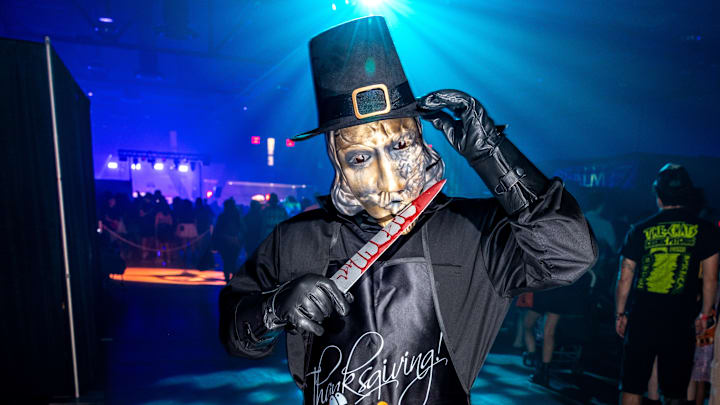In past decades, only the most hardcore of horror fans could look at a film and recognize it as a giallo, a stylized, Italian cinematic precursor to the slasher film. While classic giallos (gialli) originated from Rome’s studios, they influenced many American horror films, with three standing out.
What is a Giallo?
The Italian word “giallo” means “yellow,” and it refers to the yellowish paper once used to print salacious crime stories published in low-cost pulps. Legendary director Mario Bava invented cinematic giallos (“Gialli” in Italian) with The Girl Who Knew Too Much (1963) and the incredible Blood and Black Lace (1964). These films established the familiar tropes of the subgenre: a complex murder mystery carried out by a black-gloved or weirdly costumed killer occurs amidst red herrings, gaslighting, psychological sexual repression, and off-kilter cinematography with its vibrant colors or shocking zooms.
Giallos gained immense popularity in Italy, with other directors, such as Dario Argento, creating films like The Bird with the Crystal Plumage (1970) and the classic Deep Red (1975). European filmmakers outside of Italy began to produce homegrown giallos, such as Spain’s Paul Naschy with the offbeat Four Eyes of a Broken Doll (1974). Over time, the subgenre crossed the Atlantic, and a handful of American slasher films adopted the giallo structure, emphasizing the mystery element more heavily than the graphic body count. (Not that they didn’t have a graphic body count.) Those “old-school” American giallo horrors were few in number, but remain influential.
Night School (1981)
In 1981, everyone, from indie filmmakers to major studios, jumped on the demand for the ravenous audience of slasher movies. Night School drew attention with its brutal television commercials and a giallo-like motorcycle helmet-wearing maniac preying on (i.e., beheading) college coeds. Unlike standard slashers, this film incorporates a police procedural, heavy mystery elements, and shadowy cinematography that creates a gialli-like urban nightmare, drawing it closer to a giallo than the average gimmick-oriented stalk-and-slash opus.
Night School is evocative of the violent giallo What Have They Done to Your Daughters? (1974), which also featured a motorcycle helmet-wearing homicidal maniac with a preference for sharp implements. The stylized violence peaks with the carousel murder, where the killer spins and spins a young woman around while the camera catches the fear and chaos until a curved kukri short sword appears out of the shadows and into a direct decapitation path. Night School cribs enough giallo elements to stand out, but it was not a big hit despite Paramount serving as its distributor.

Happy Birthday to Me (1981)
Happy Birthday to Me featured one of the most absurd poster visuals ever: death by shishkabob. While that image is decidedly non-giallo, the presence of a mysterious black-gloved killer and the mystery surrounding who he or she is keep audiences on edge as, one by one, prep school students meet strange demises. Student Ginny questions her sanity (a molto giallo trope) as she tries to make sense of the red herrings among multiple suspects.
Director J. Lee Thompson worked as a “gun for hire” as producers John Dunning and André Link developed the film to cash in on Halloween’s success. Yet, genre-jumping Cape Fear (1962) and Conquest of the Planet of the Apes (1972) director skillfully balanced the required giallo elements, such as the bench press death sequence, where tight camera framing hides the black-gloved killer’s head and identity, in an American slasher. The effective subgenre blending resulted in one of the top entries in the crash-and-burn cycle.
Alice, Sweet Alice (1976)
Alice, Sweet Alice is arguably the quintessential American giallo since it arrived four years before the slasher craze took off, so it didn’t borrow weaker conventions from pure exploitation movies. Did twelve-year-old Alice murder her younger sister? And could she be responsible for the other mysterious murders that soon follow? Alice suffers from neurotic issues, as happens to many prime murder suspects in a giallo.
Alice, Sweet Alice is a triumph of 1970s horror, with one unexplained, giallo-paced murder occurring after another. The bizarre killer in a raincoat with a see-through Halloween mask is an outstanding Americanized variant of a traditional giallo costume, and the film maintains traditional giallo editing approaches, like the curious shot choices and hyperactive quick cuts during the perverted landlord’s death. What is decidedly UN-giallo is the killer’s early reveal, well before the climax. That odd touch further helps the film establish a unique identity while keeping true to giallo elements.
Taking Off the Gloves
While Happy Birthday to Me garnered moderate success at the box office, Night School and Alice, Sweet Alice did poorly. All three films developed a cult following, thanks to their VHS release and recommendations from horror film enthusiasts.
American giallos are not rare today because many modern indie horror filmmakers draw inspiration from them. Maybe one of those filmmakers will outdo Alice and become the best of the American black-gloved mystery killer fantasy world.
